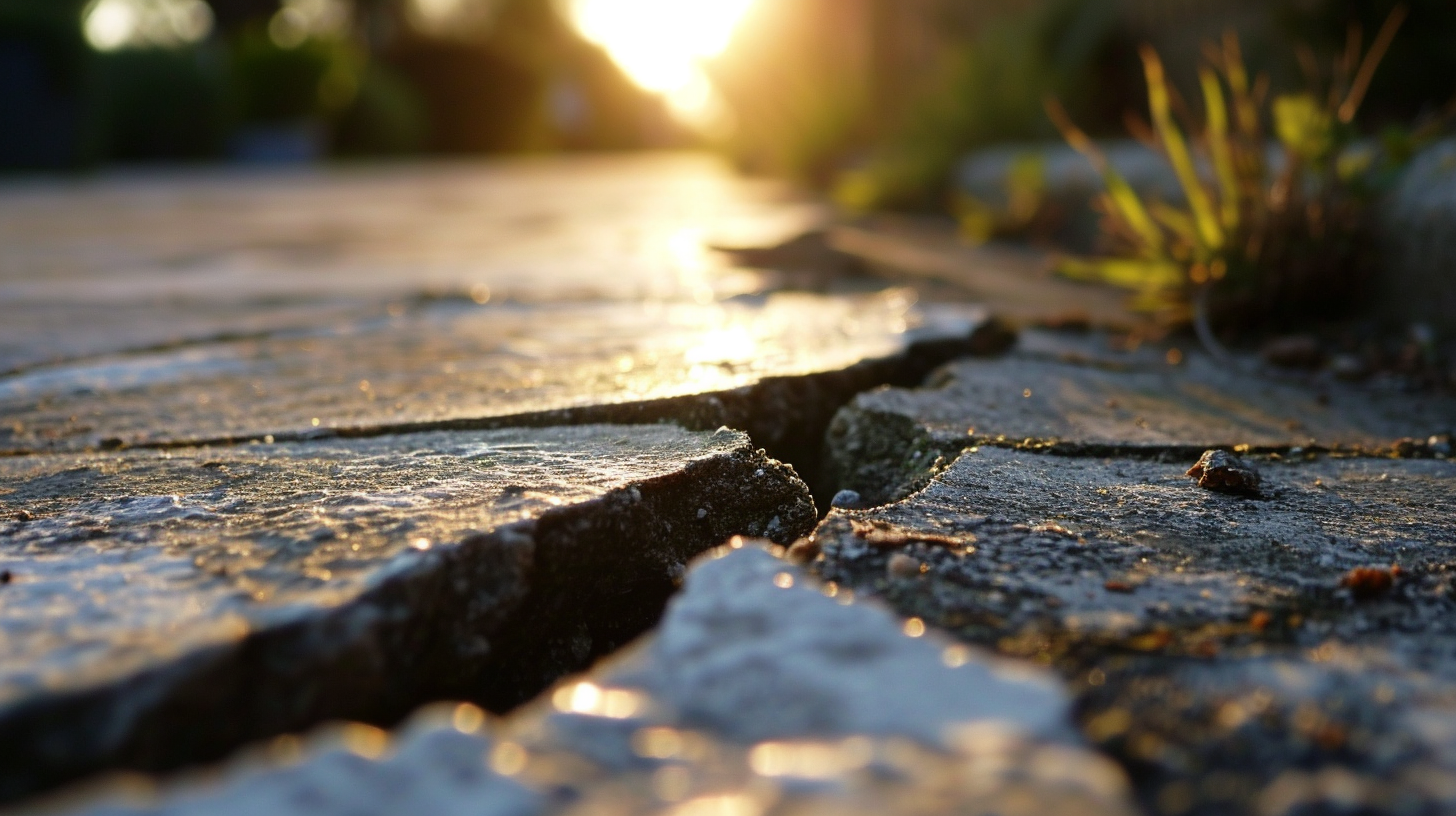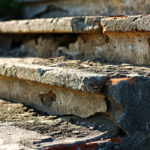Last Updated on 26th December 2023
Cracked sidewalks not only compromise the aesthetic appeal of our surroundings but also pose safety hazards. In this article, we will explore the step-by-step process of repairing a cracked sidewalk. From assessing the damage to gathering the necessary tools and materials, we will guide you through the entire repair procedure. By following our professional advice, you will be able to restore the integrity and functionality of your sidewalks, ensuring a safe and visually pleasing environment.
Assessing the Damage
In order to accurately assess the damage to the cracked sidewalk, a thorough inspection must be conducted by a professional contractor. Evaluating the extent of the damage is crucial to determine the appropriate repair method and materials required. The contractor will carefully examine the entire length of the cracked sidewalk, looking for any signs of underlying issues or potential hazards. This inspection will involve measuring the width and depth of the crack, as well as assessing any displacement or unevenness in the affected area. Additionally, identifying the cause of the crack is essential to prevent future damage. The contractor will inspect the surrounding environment, considering factors such as tree roots, soil erosion, or poor drainage that may have contributed to the cracking. By conducting a comprehensive evaluation, the contractor can provide an accurate assessment and recommend the most suitable repair solution.
Gathering the Necessary Tools and Materials
When it comes to repairing a cracked sidewalk, gathering the necessary tools and materials is crucial. Having the right equipment on hand will ensure a smooth and efficient repair process. Additionally, selecting the appropriate materials for sidewalk repair, such as concrete mix and sealant, is essential for achieving long-lasting results.
Essential Repair Equipment
The proper selection and utilization of the essential repair equipment, such as a concrete crack filler, a trowel, and a wire brush, is crucial for effectively repairing a cracked sidewalk. When it comes to repair equipment selection, it is important to choose tools that are specifically designed for sidewalk repair. A concrete crack filler is essential for filling in the cracks and preventing water from seeping in, which can further damage the sidewalk. A trowel is necessary for applying the crack filler smoothly and evenly, ensuring a seamless repair. Additionally, a wire brush is important for cleaning the cracks and removing any loose debris before applying the crack filler. Safety precautions should also be taken into consideration when using the repair equipment, such as wearing protective gloves and eyewear to avoid any injuries. By using the appropriate repair equipment and following safety precautions, a cracked sidewalk can be effectively repaired, ensuring its longevity and safety for pedestrians.
Materials for Sidewalk Repair
To effectively repair a cracked sidewalk, it is crucial to gather the necessary tools and materials, such as concrete mix, a trowel, and a joint compound. However, the materials used for sidewalk repair can vary depending on the severity of the cracks and the desired outcome. Common materials for sidewalk repair include concrete resurfacer, crack filler, and sealant. Concrete resurfacer is a thin layer of cement that can be applied over the existing sidewalk to give it a fresh look. Crack filler is used to fill in small cracks, preventing them from expanding and causing further damage. Sealant is applied to the surface of the sidewalk to protect it from moisture and other elements. The cost of sidewalk repair materials can vary depending on the brand and quantity needed. It is important to consider the quality and durability of the materials to ensure a long-lasting repair.
Preparing the Cracked Sidewalk for Repair
Several necessary steps must be taken to adequately prepare a cracked sidewalk for repair. One of the first steps is preparing the ground beneath the cracked sidewalk. This involves removing any debris, such as loose stones or dirt, to ensure a clean and stable base. Safety precautions should also be taken during this process, including wearing protective gear and using proper tools. Once the ground is prepared, the next step is to assess the extent of the damage and determine the best repair method. This may involve filling the cracks with an appropriate material, such as concrete or asphalt, or replacing sections of the sidewalk altogether. Ultimately, proper preparation is essential to ensure a long-lasting and safe repair for the cracked sidewalk.
Filling the Cracks With Concrete Patching Compound
Using concrete patching compound is an effective method for filling the cracks in a sidewalk. Concrete crack filler is specifically designed to fill and seal cracks in concrete surfaces, including sidewalks. This compound is easy to use and provides a long-lasting solution to repair damaged sidewalks. It is important to choose a high-quality concrete patching compound that is durable and weather-resistant.
While there are alternative repair methods available for cracked sidewalks, such as using epoxy or polyurethane sealants, concrete patching compound remains a popular choice due to its affordability and ease of use. These alternative methods may provide a more flexible or adhesive solution, but they can also be more expensive and require professional application.
Smoothing and Leveling the Repaired Area
After filling the cracks with concrete patching compound, it is important to smooth and level the repaired area to ensure a seamless finish. Smoothing techniques and leveling methods play a crucial role in achieving a professional-looking result. One common method is to use a trowel to spread the patching compound evenly across the repaired area. By applying light pressure and using smooth, sweeping motions, the trowel helps to create a flat and uniform surface. Another technique is sanding, which involves using sandpaper or a sanding block to smooth out any rough edges or unevenness. This is particularly useful for larger repairs or areas that require more precision. Additionally, using a level can help ensure that the repaired area is even and aligned with the surrounding sidewalk. By employing these smoothing techniques and leveling methods, the repaired area will seamlessly blend with the rest of the sidewalk, restoring its functionality and aesthetic appeal.
Curing and Sealing the Repaired Sidewalk
Curing and sealing the repaired sidewalk is essential to ensure the longevity of the repair. Proper sealing techniques, such as using a high-quality sealant and applying it evenly, can help protect the repaired area from water damage, freeze-thaw cycles, and other weathering effects. Additionally, a well-sealed sidewalk can enhance its overall appearance and make it more resistant to future cracks and deterioration.
Best Sealing Techniques
With the appropriate application and careful consideration of temperature and humidity levels, achieving optimal results during the sealing process is crucial for the long-term durability and aesthetic appeal of the repaired sidewalk. When it comes to the best sealing techniques, it is essential to use high-quality sealing products and professional sealing services. The choice of sealing products plays a significant role in the effectiveness and longevity of the seal. High-quality products are designed to withstand heavy foot traffic, harsh weather conditions, and UV rays, ensuring that the seal remains intact for an extended period. Additionally, professional sealing services provide expertise and experience in properly applying the seal, ensuring even coverage and proper adhesion to the repaired sidewalk. By utilizing the best sealing products and professional sealing services, the repaired sidewalk can maintain its structural integrity and visual appeal for years to come.
Longevity of Sealed Repairs
For optimal longevity, it is crucial to carefully maintain and regularly inspect sealed repairs on the sidewalk. Sealed repairs offer several longevity benefits, such as preventing water infiltration, reducing further damage, and extending the lifespan of the sidewalk. By effectively sealing cracks and joints, the repaired sections are protected from moisture, which can cause erosion and deterioration. Regular inspections allow for early detection of any potential issues, such as cracks or gaps that may have developed over time. However, there are potential drawbacks to consider. Over time, the sealant may degrade due to exposure to harsh weather conditions or heavy foot traffic, requiring periodic reapplication. Additionally, improper sealing techniques or the use of low-quality materials may result in a shorter lifespan for the repairs. Therefore, it is important to choose a reputable contractor and use high-quality sealants to ensure the longevity of sealed repairs on sidewalks.
Maintaining and Preventing Future Cracks
Although crack repairs are essential, implementing proper maintenance techniques is crucial for preventing future cracks in a sidewalk. In order to prevent erosion and ensure the longevity of the repair, it is important to choose the right repair method. There are several options available, including patching, filling, and sealing. Patching involves removing the damaged section of the sidewalk and replacing it with new concrete. Filling, on the other hand, involves filling the crack with a flexible material that expands and contracts with the changing weather conditions. Sealing is another effective method that involves applying a protective layer over the cracked area to prevent water and other elements from seeping in. It is important to consider the severity of the crack, the location, and the expected foot traffic when choosing the right repair method. Regular inspections and maintenance can help identify and address any potential issues before they turn into major cracks. By taking proactive measures, such as preventing erosion and choosing the right repair method, it is possible to minimize the occurrence of future cracks in a sidewalk.




